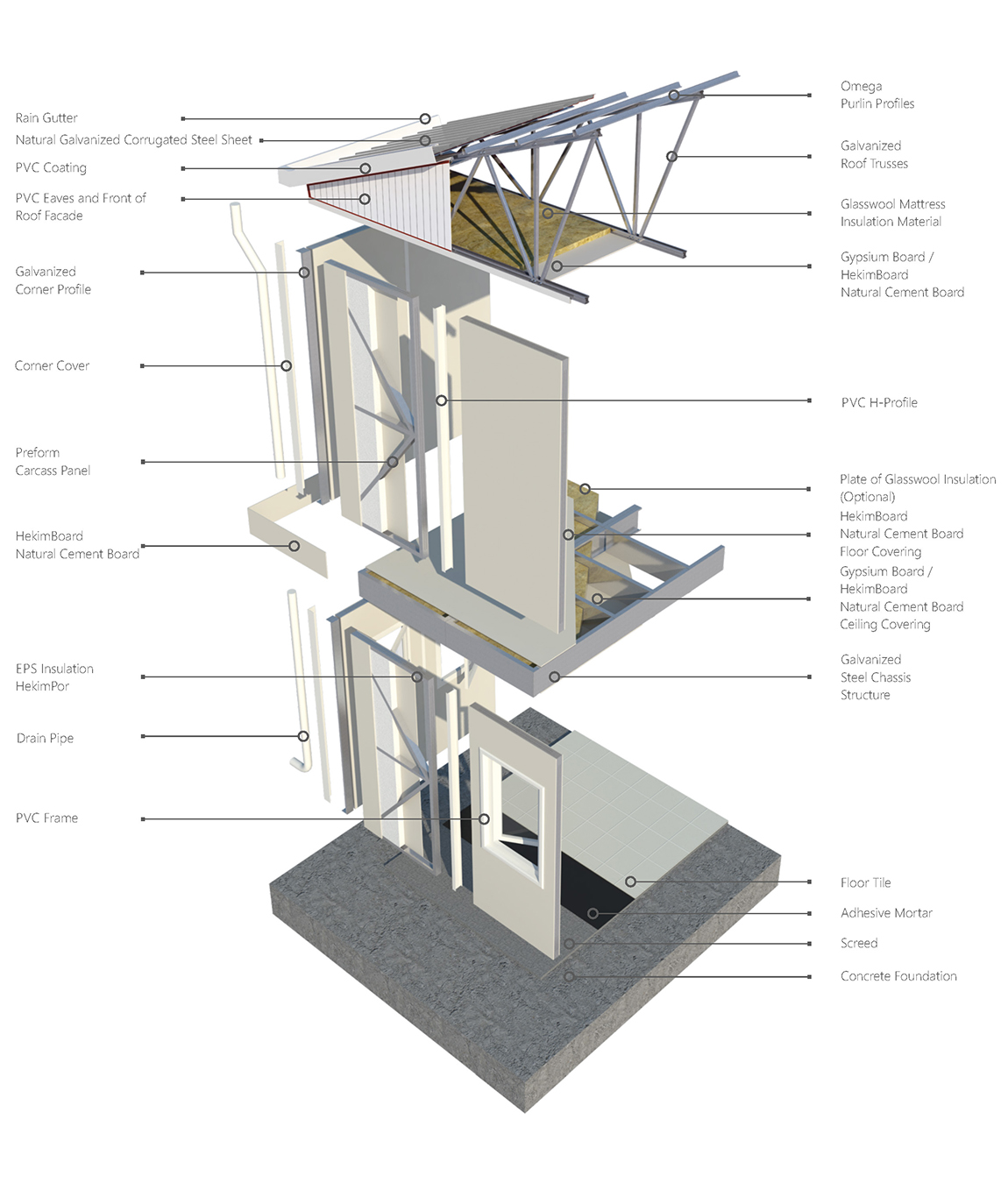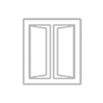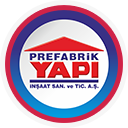Carcass Panel System
Hekim Carcass Panel System
Cross Section of Carcass Panel System

Technical Specifications

Construction

Wall
Optional
- Patterned HekimBoard Natural Cement Board
- Fuga Patterned HekimBoard Natural Cement Board
- Turksiding Patterned Natural Cement Board

Roof
Optional
- Painted galvanized corrugated steel sheet
- Hekim sandwich roof pannel
- High quality, bitumen based covering
- Corrugated bituminous sheet covering
- Patterned membrane
- Metal roof tile
- PVC / metal rain gutter and drain pipe

Insulation
Matress glasswool is use for insulation of roof.
Optional
- Glasswool
- Rockwool
- Rockwool

Doors
Interior doors are MDF-Laminated
Optional
- Aluminium
- Steel
- PVC
- Fireproof door
- Aluminium
- American door (Steel sheet or wooden frame)
- PVC
- Fireproof door

Windows
Optional
- Colored and wood patterned PVC frame
- Colored and wood patterned aluminium frame
- Sliding or guillotine frame
- Tilt & turn frame
- Thermal insulated aluminium frame
- Aluminium or PVC roller shutters
- Insect screen

Paint
Hekim plastic paint is used for interior wall surface.
Optional
- Satin paint
- Patine paint

Electrical Installation
The installation is surface mounted.
Optional
- Flush mounted installation
- Telephone line
- Data line
- UPS
- TV
- Fire detection system
- Alarm and smart building systems

Sanitary Installation
Installation is surface mounted.
Optional
- Flush mounted installation
- WC with ceramic flush tank
- Pedestal wasbasin
- Eastern WC
- Bathtub
- Special kitchen cabinet
- Fire extinguishing system
- Heating and Ventilation system
What Is a Carcass Panel?
A carcass panel is essentially the structural framework of a piece of furniture, designed to support and shape the overall design. It is a system that typically consists of a combination of panels arranged to create a solid structure. These panels can be made from various materials, each offering different levels of durability, weight, and aesthetic appeal. The carcass panel construction is fundamental in ensuring that the furniture is both functional and visually appealing.
How Is a Carcass Panel Structured?
The structure of a carcass panel usually involves a combination of vertical and horizontal elements that create a sturdy framework. It is typically designed as a box-like configuration, providing ample space for storage while maintaining a compact shape. The edges of the panels are often finished or beveled to enhance durability and appearance. Additionally, carcass panels may include reinforcements or hardware attachments to facilitate the installation of doors, drawers, and other components.
What Are the Technical Specifications of Carcass Panels?
Carcass panels come with various technical specifications that determine their suitability for different applications. Key specifications include:
- Thickness: Typically ranges from 15mm to 25mm, affecting strength and weight.
- Material: Options like MDF, plywood, and particle board, each with unique properties.
- Load-bearing capacity: Must be adequate for the intended use, especially in storage furniture.
- Edge banding: Used to protect edges from moisture and wear, enhancing longevity.
- Surface finish: Affects aesthetics and can be laminated, veneered, or painted.
What Types of Carcass Panels Exist?
There are several types of carcass panels, each designed for specific needs and preferences:
- MDF Carcass Panels: Made from medium-density fiberboard, known for smoothness and versatility.
- Particle Board (Chipboard) Carcass Panels: Composed of wood chips, offering a cost-effective solution.
- Plywood Carcass Panels: Made from layers of wood veneer, prized for strength and durability.
- HPL (High-Pressure Laminate) Carcass Panels: Feature a laminate surface, providing excellent resistance to scratches and moisture.
MDF Carcass Panels
MDF carcass panels are highly favored in the furniture industry due to their smooth surface and ease of machining. Made from wood fibers bonded with resin, these panels offer excellent durability and stability. They are ideal for painted finishes, allowing for a sleek, modern appearance. However, MDF panels are not water-resistant, so they require proper sealing in moist environments. Their versatility makes them suitable for a variety of applications, including cabinetry and custom furniture design.
Particle Board (Chipboard) Carcass Panels
Particle board carcass panels are an economical choice for furniture construction, made from compressed wood particles. They offer a lightweight structure, making them easy to handle and install. While not as strong as MDF or plywood, they are suitable for low to medium load applications. These panels are often veneered or laminated to improve appearance and resistance to moisture. Particle board panels are widely used in cabinets and office furniture, providing a budget-friendly solution without sacrificing style.
Plywood Carcass Panels
Plywood carcass panels are constructed from multiple layers of wood veneer, providing exceptional strength and flexibility. They are highly durable and resistant to warping, making them ideal for various environmental conditions. Plywood panels can be exposed to moisture, allowing their use in kitchens and bathrooms. Their natural wood aesthetic offers a classic look, but they can also be painted or stained. Plywood carcass panels are suitable for high-quality furniture and architectural applications due to their superior performance.
HPL (High-Pressure Laminate) Carcass Panels
HPL carcass panels are known for their robust surface, combining aesthetic appeal with high durability. These panels are made by compressing layers of laminate under high pressure, resulting in a scratch and moisture-resistant material. HPL panels are easy to clean, making them ideal for environment applications. They come in various designs and colors, allowing for creative versatility in furniture design. HPL carcass panels are commonly used in commercial settings as well as in modern residential furniture.
Benefits of Using Carcass Panels
Using carcass panels in construction offers several advantages. They provide a stable and robust framework, ensuring the longevity of furniture pieces. Carcass panels enable efficient storage solutions, allowing for customized spaces within cabinets and closets. The variety of materials and finishes available allows for flexibility in design, catering to different aesthetic preferences. Additionally, carcass panels contribute to faster assembly times in furniture production, making them a popular choice among manufacturers and designers alike.
How Are Carcass Panels Manufactured?
The manufacturing process of carcass panels involves several key steps to ensure quality and durability. Firstly, raw materials are selected based on the desired panel type; these materials are then processed into sheets. Cutting the panels to size is followed by applying edge banding to protect them from moisture. Surface finishing is done to enhance appearance and durability. Finally, the panels undergo quality control inspections to ensure they meet the technical specifications required for various applications.
How Are Carcass Panels Installed?
Installing carcass panels requires careful planning to ensure proper alignment and stability. Firstly, the installation area should be measured accurately to determine panel placement. Using appropriate hardware, panels are secured together to form the desired structure. It is essential to check for level and plumb during installation, especially for wall-mounted units. Once installed, doors and drawers can be added, completing the carcass panel system. Proper installation techniques contribute to the functionality and longevity of the furniture.
Applications of Carcass Panels
Carcass panels are versatile and used in various applications across residential and commercial settings. They are commonly found in kitchen and bathroom cabinets, providing essential storage while maintaining a sleek look. In offices, carcass panels are utilized for desks and filing systems, promoting organization. Additionally, these panels are employed in retail environments for display units. Their adaptability makes carcass panels suitable for numerous designs, fulfilling different functional and aesthetic requirements in diverse spaces.
Choosing the Right Frame Panel for Your Project
Selecting the appropriate frame panel for a project involves considering several factors. Firstly, assess the specific functional requirements, such as load-bearing needs and moisture exposure. Secondly, determine the desired aesthetic; different materials offer various finishes and styles. Budget constraints also play a crucial role in material selection; choose a panel type that balances cost and quality. Finally, consider the manufacturing and installation processes to ensure they align with your project timeline and expertise.
